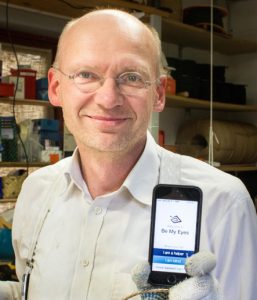How it works and who created it
"Be My Eyes" is an app that serves to help people who are blind or visually impaired, but is very different from all the other hi-tech apps available today in Apple or Google stores for this same purpose.
The big difference lies in the fact that 'Be My Eyes' is based on the principle of human solidarity that drives sighted people to 'becoming eyes' of those who cannot enjoy the precious gift of sight. The channel that allows this app to reach the top today is the web and in particular the solidarity network that can be activated through social networks.
The operation of 'Be my eyes' is in fact based on the request for help, conveyed through the app, which allows users to find someone among the subscribers who at that moment is willing to lend their healthy eyes to a blind person in difficulty, for example in checking the expiry date of a product, finding the right direction in the street or even finding a lost object. The app transfers the video taken by the camera of the blind person's smartphone to the display of the volunteer, who can then respond to the requests made.
Launched in 2015, 'Be My Eyes' has now reached 1,210,378 volunteers, while the total number of registered blind and visually impaired people is 77,648 in 150 different countries.

But how did 'Be My Eyes' come about? Its creator is Danish Hans Jørgen Wibergwho at the age of 25 started to lose his sight just as he was about to take over the running of the family farm from his parents. He was then diagnosed with retinitis pigmentosa, a progressive retinal disease with a genetic basis for which, unfortunately, there is still no curative therapy.
Hans, who today has 'tunnel vision' with only 5° of vision, could then have been discouraged and given up and instead went on to university, got married and had two children.
He was still studying philosophy when he came up with the idea in 2012 to provide blind and visually impaired people with the eyes of healthy volunteers willing to help them with small everyday difficulties.
It took three years to develop, both because of the need to subject the new app to proper testing and to find the necessary funds to finance its realisation.
Today, however, 'Be My Eyes' is a reality that helps and connects many people, also thanks to its usability in multiple languages.
Clearly, since Be My Eyes relies on the voluntary involvement of a large number of people, who are not subject to prior checks or controls, the blind or visually impaired person must not share data such as credit card codes, identity documents, pictures of a personal nature, data concerning health conditions, and so on through the app.
For more information on the do's and don'ts of Be My Eyes, please visit https://www.bemyeyes.com/get-started
Dr. Carmelo Chines
Direttore responsabile
